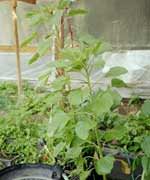
Image credit: ISECCo
Ray and some friends built Mars Base Zero a few years ago on a borrowed plot of land just outside Fairbanks, Alaska. It’s a fairly normal looking greenhouse 11 metres (36 feet) long, and two-thirds as wide. One half of the cylindrical roof is clear plastic, and the other half is well insulated. There’s also a small apartment attached to one end for Ray to live in while he tends to his Martian garden.
Inside you’ll find a healthy crop of potatoes, carrots, cabbage, tomatoes, and plenty of other produce to make a vegan smile – mostly, though, you’ll find potatoes. Through several years of experimentation, Ray has learned that a single human requires about 80 square metres (864 square feet) of soil to grow enough food to survive.
Assuming you’re willing to eat a lot of potatoes.
“We tried growing wheat, but we could have gotten several pounds of potatoes for an area that gave me just a cupful of wheat. I’m guessing that 4-5 chickens would eat the same amount as me. We might try fish, though.”
Collins is one of the original co-founders of the International Space Exploration and Colonization Co. (ISECCo); a non-profit organization hoping to contribute knowledge to the human exploration of space. Instead of building rockets in their garages, the ISECCo team decided to do something much lower budget: Closed Ecological Life Support System Research. Sort of like Biosphere II, but without all the fancy ecosystems… and drama.
They started in 1988, and built a series of experiments leading up to Mars Base Zero – a $30,000 investment. Maintaining the experiment has only cost $900 this year, since they planted the crops in May 2004. Ray figures he’s put $40,000 of his own money into the various experiments since 1988.
The only purpose of Mars Base Zero is to understand how much space is required, and which crops to grow to keep an astronaut well fed. If you could seal it up tight, and ship it to Mars, Ray figures that it would get enough sunlight on Mars to have the plants nearly growing as well as they do in Alaska.
Ray began this experiment on September 17, and he’s been keeping a detailed log of the food he’s been eating – the potatoes he’s been eating – and the, um, “waste” he’s been generating. He hasn’t lost any weight so far, but he has to eat several kilograms of food every day just to maintain. A nutritionist probably wouldn’t be too pleased with his diet so far, but Ray’s aware of the inadequacies and has new crops planned for next time around. If everything goes well, he’ll stay in for at least 30 days, and maybe as long as 60 days if the potatoes hold out. His wife is expecting to deliver their second child in December, so Ray’s got a hard deadline anyway.
Normally they plant in the spring, and then harvest in the fall. But Ray would like to try planting continuously, and keep it going as long into the winter as he can afford to pay for lights and heat. Eventually he hopes they’ll get to the point that it’s a year round operation.
And then they’ll take the experiment to the next level… underground.
ISECCo plans to build an underground dome, called Nauvik (Eskimo term for “nurturing place”), twice the same area as the greenhouse, but seal it completely off from the Earth’s environment. Water, air and other nutrients would be carefully monitored, and the plants would be grown by powerful lamps – the electricity bill alone will probably run $5,000 a month. The advantage is that they could simulate a lunar or Martian environment; even experimenting with different air pressures to see how the plants react. With the heat from the lamps, Ray expects one of the most difficult challenges will be keeping it cool.
It’ll be an expensive proposition. Especially without government or NASA funding. “We responded to a NASA request-for-proposal that was looking for unique ideas in closed system life support.” Ironically, the agency complained that their idea was “too unique”.
Maybe the astronauts weren’t willing to eat that many potatoes.
Written by Fraser Cain
